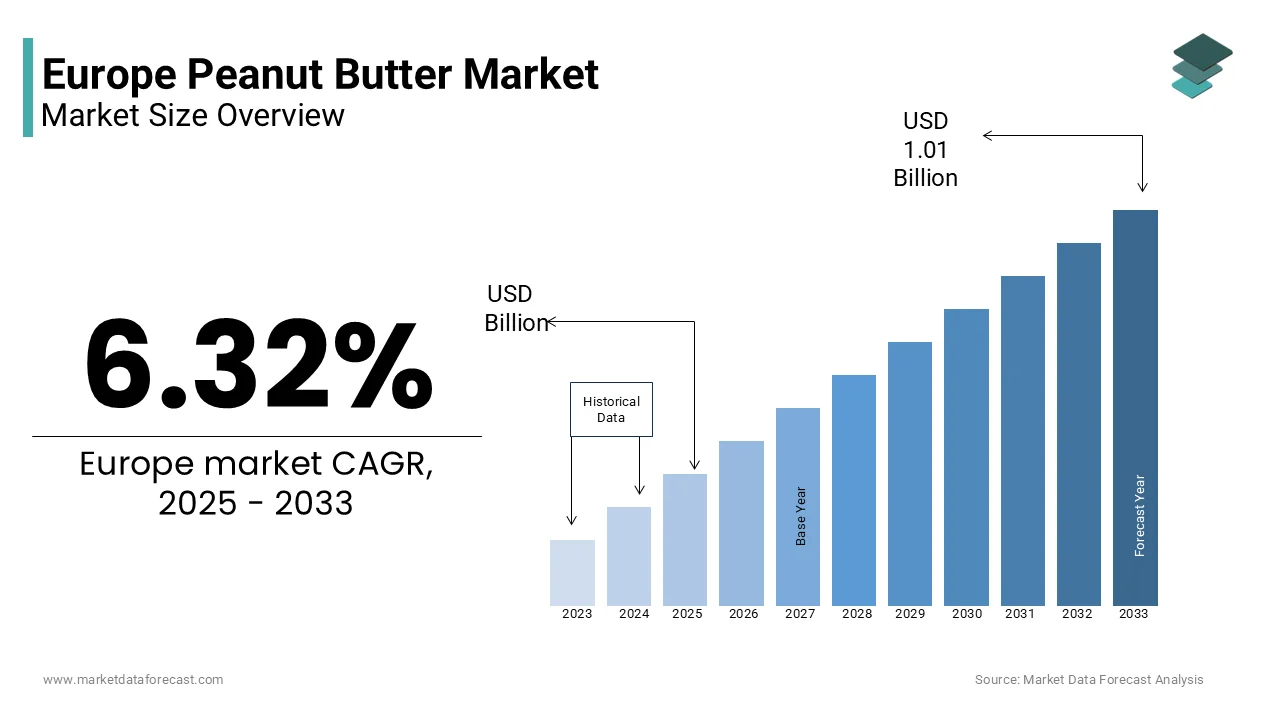Europe Peanut Butter Market Research Report – Segmented Based on Product (Crunchy, Creamy, and Others (Flavored/Specialty)), Brand Type, Distribution Channel and Country (UK, France, Spain, Germany, Italy, Russia, Sweden, Denmark, Switzerland, Netherlands, Turkey, Czech Republic & Rest of Europe) - Industry Analysis on Size, Share, Trends, Growth Forecast (2025 to 2033)
Europe Peanut Butter Market Size
The size of the European peanut butter market was worth USD 1.93 billion in 2024. The European market is expected to grow at a CAGR of 6.32% from 2024 to 2032 and the regional market size is predicted to be worth USD 3.35 billion by 2033 from USD 2.05 billion in 2025.

MARKET OVERVIEW
Peanut butter is a food paste or spread made from ground, dry, roasted peanuts. It often contains additional ingredients that modify the texture or taste, such as sweeteners, salt, or emulsifiers. Peanut butter is popular in many countries around the world. Peanut butter is served as a spread on toast, bread, or crackers and is used in making sandwiches, notably the peanut butter and jelly sandwich. It is also used in numerous confections and packaged foods, such as Reese's Peanut Butter Cups, which is made of chocolate-coated peanut butter, and candy bars, which are made from peanut butter-flavored Snickers and peanut-flavored granola bars. Comparable preparations are made by grinding other nuts. A variety of other nut butter, such as almond butter and cashew butter, are also sold.
The driving factors of the Europe Peanut Butter market are the growing demand for nutritious products coupled with the increasing disposable income of consumers, particularly in developing countries. Other drivers that are driving the growth of the peanut butter market are the emergence of hectic life schedules and the growing demand for low-calorie healthy food. Changing lifestyles and shifting towards the intake of convenient food are also some factors that are expected to drive the Europe peanut butter market in the forecast period.
A major constraint that is expected to hinder the growth of the peanut butter market is the availability of peanuts at competitive prices coupled with fluctuating peanut production.
KEY MARKET PLAYERS
Some of the major players in the market are Procter & Gamble, Unilever, The J.M. Smucker Company, Hormel Foods Corporation, Boulder Brands Inc., Kraft Canada Inc., and Algood Food Company Inc.
MARKET SEGMENTATION
This research report on the Europe peanut butter market has been segmented and sub-segmented based on the following categories.
By Product
- Crunchy
- Creamy
- Others (Flavored/Specialty)
By Brand Type
- Branded
- Private-Label
- Others (Artisanal and Specialty manufacturers)
By Distribution Channels
- Supermarkets & Hypermarkets
- Convenience Stores
- Online Stores
By Country
- UK
- France
- Spain
- Germany
- Italy
- Russia
- Sweden
- Denmark
- Switzerland
- Netherlands
- Turkey
- Czech Republic
- Rest of Europe
Related Reports
Access the study in MULTIPLE FORMATS
Purchase options starting from
$ 2000
Didn’t find what you’re looking for?
TALK TO OUR ANALYST TEAM
Need something within your budget?
NO WORRIES! WE GOT YOU COVERED!
Call us on: +1 888 702 9696 (U.S Toll Free)
Write to us: sales@marketdataforecast.com